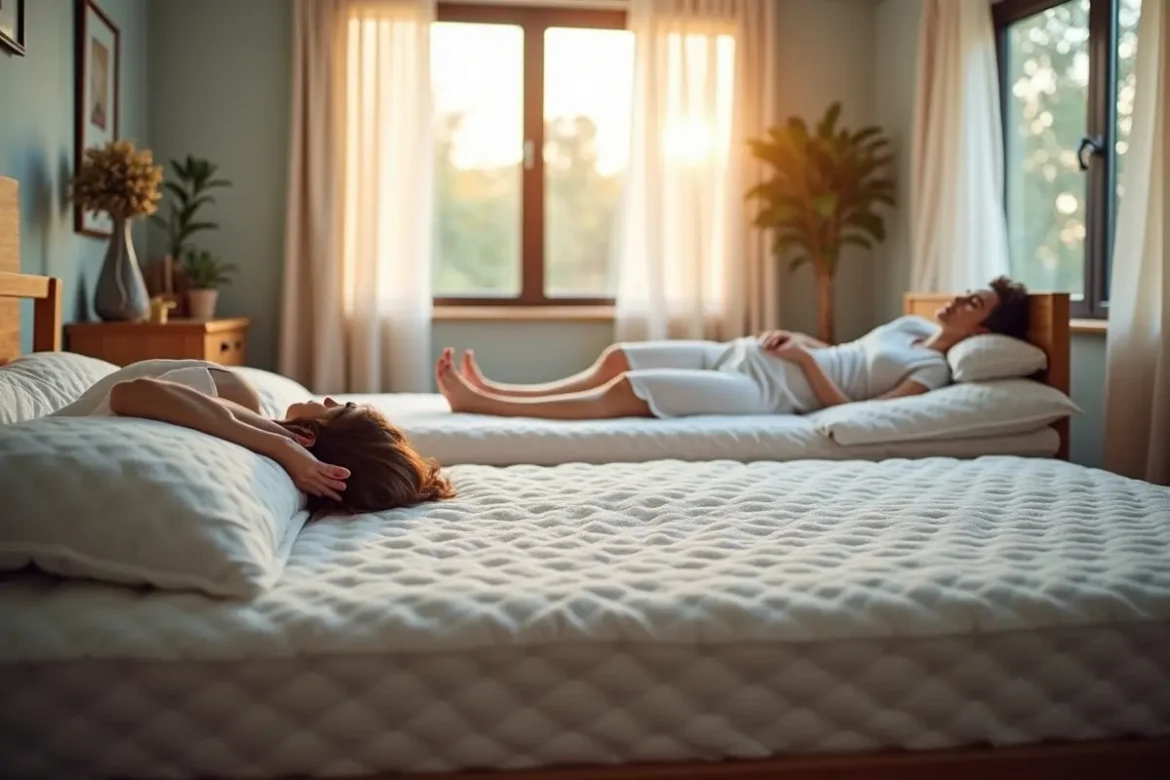
Looking for a new bed?
Choosing the best bed involves more than simply picking a model that’s within your budget or that you think looks good. You must first identify your sleep preferences and understand the type of bed that will actually benefit your body. After all, we all spend about one-third of our lives in bed.
The Problem:
Most people go out and purchase beds according to their price tags and aesthetics. They don’t give much thought to their sleep position, body type, and comfort levels when they are sleeping. Then they wonder why they feel sore and stiff in the morning.
Fact: 54.1% of people sleep on their sides.
They need to consider their sleeping position before they start their buying journey. Each sleeping position needs a different type of bed, and it must be made clear to the consumers that all mattresses don’t work equally well for them.
In this article, I will cover
- The Different Sleep Positions and the Best Beds for Each
- Finding Bed Options For Every Type of Sleeper
- Why your sleep position is important while choosing a bed?
- The mattress types that work with every sleeper
- The storage beds that provide ample space and look good.
In the present post I have covered a detailed discussion on how to choose the right kind of mattress for the various body types.
Contents
Sleep Position is Crucial When Picking the Right Bed
Before you start looking at beds, there’s one fact you need to keep in mind…
Your sleep position is crucial.
Side sleepers need deep cushioning for their shoulders and hips. Back sleepers require firm support to keep the spine aligned. Stomach sleepers need yet another solution.
Storage beds also play a crucial role when you buy the best mattress that suits you. The Bed Supermarket has made it convenient by providing ottoman beds which not only fit into your body requirements but also provides you with adequate storage space so that you can increase the space in your bedroom.
The best bed will support your body instead of misaligning your spine. No more groggy mornings!
Types of Beds that Works For Each Type of Sleeper
Now we shall discuss which beds work best for which sleepers…
Side Sleepers (The Majority)
Sleeping on your side is by far the most popular sleeping position. However, it comes with its own set of requirements.
Side sleepers apply pressure on their shoulders and hips throughout the night. So they require a bed that offers enough cushioning to relieve pressure while supporting the spine.
The best options include:
- Medium to medium-soft mattresses.
- Memory foam mattresses that mould to your body.
- Hybrid mattresses that offer pressure-relieving surface layers.
- Pillow-tops for added cushioning.
Avoid anything that is too firm. An overly hard mattress will press against the shoulders and hips, causing painful pressure points.
Back Sleepers (The Goldilocks Position)
Back sleepers are in the best position – quite literally. Sleeping on your back keeps your spine in neutral alignment… Provided you have the right bed.
According to a survey, 40% of consumers have believed that changing their mattresses will enhance the quality of their sleep. This improvement is possible when they stick to the basics when choosing the bed. The consumers who have back pain and prefer sleeping on their backs can get the most benefit from a correct mattress.
You need a bed that will support your lower back’s natural curvature without letting any gap to create. If it’s too soft, your hips will sink down. If it’s too hard, your lower back will receive no support.
You need to look for the following:
- Medium-firm mattresses.
- Innerspring mattresses with a good support system.
- Hybrid mattresses that offer a balance between comfort and support.
- Mattresses with zoned support for different body parts.
The aim is to keep the spine in neutral position all through the night.
Stomach Sleepers (The Rare Ones)
Only about 7% of people sleep on their stomach. If you’re one of them, you require a firmer bed.
Stomach sleeping can lead to lower back pain if the bed is too soft. When you sleep on your stomach, your mid-section sinks down, putting your spine in unnatural extension.
A firmer bed will keep the body on a more even plane, preventing that painful hyperextension of the lower back.
The best choices for stomach sleepers include:
- Firm mattresses.
- Innerspring mattresses with a strong support core.
- Latex mattresses (they are firmer by nature).
- Mattresses that are not too plush.
Some stomach sleepers prefer using a thin pillow-top. But a thick, plush pillow-top will not work.
Matching Your Bed To Your Body Type
Weight plays an important role too.
Light sleepers (under 130 pounds) don’t sink into beds much. So they can afford to choose a softer bed and still get support. A medium-soft to medium bed will work well.
Average weight sleepers (130-230 pounds) have the most choice. Medium to medium-firm beds tend to work best for them. Most bed manufacturers focus on this weight range.
Heavy sleepers (over 230 pounds) need firmer, more supportive beds. Softer beds cause them to sink deeper, leading to alignment issues. A firm bed with a good support core will work best for them.
Sleep position and body type combined tell you the perfect bed to go with.
For example… A heavy side sleeper will need a firmer bed than a light side sleeper, but a softer bed than a heavy stomach sleeper would need.
Storage Beds without Harming the Comfort Levels
Here’s something most articles on picking the right bed miss out…
Storage.
Bedroom space is at a premium. It’s especially true if you live in small houses or apartments. That’s where ottoman beds or storage beds come to the rescue.
They have a compartment below that lifts up to reveal ample storage space. You can use it to store additional bedding, off-season clothes, shoes, accessories, whatever you need to stash away.
The trick is:
Storage beds can be just as comfortable as normal beds. The storage mechanism is underneath the mattress, so it doesn’t interfere with the sleeping surface in any way. You can still choose the type of mattress and firmness that suits your sleep position.
Gas-lift mechanisms are used in modern ottoman beds. They make the lifting motion smooth and effortless.
Decision Making Process
Ready to make a decision?
Identify your primary sleep position first. Then factor in your body type. These two considerations immediately narrow down your choices.
Don’t forget about:
- Your partner’s sleep preferences (if you’re shopping for two)
- Any existing pain or health issues you have
- Your budget and the long-term value of the bed
- Storage requirements and available bedroom space
- Trial periods and return policies
The majority of bed retailers provide trial periods. Don’t hesitate to take advantage of it. You have to give your body time to adjust to a new bed. So it’s best that you give it at least 30 days before you start deciding about it.
The best bed is the one that properly supports your body, is made for your sleep position and helps you to wake up refreshed.
In Conclusion
Selecting the right bed isn’t that difficult if you understand a few basics.
Know your sleep position. Factor in your body type. Select a bed that’s suitable for both. And don’t compromise on comfort just to save a few bucks. You will end up paying for it in reduced sleep quality.
The ideal bed will:
- Keep your spine properly aligned
- Relieve pressure points
- Keep you comfortable all night
- Last you for years with proper care
Don’t rush the decision. Take your time to get it right. Your body will thank you every morning.



